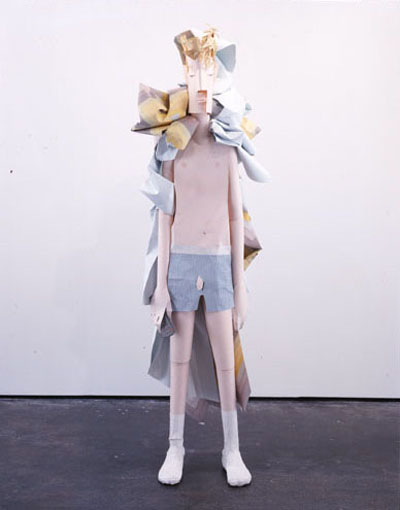 Ghosting, 2004 paper, acrylic paint, epoxy, color-aid, matte medium, aluminum rod, wire, 74" x 22" x 22" Ryan Johnson Modern Human Animal Ryan Johnson is a sculptor whose adept draughtsmanship is in the vein of such caricaturists as George Grosz, Honore Daumier, and Ralph Steadman. It is from the medium of drawing that he lifts his primary material: paper. His confidence in the wavering structural integrity of his chosen medium leads his figurative sculpture to new heights- actually, full human height, and it is against this sense of scale that he plays his most subtle formal deceptions. Johnson's shifting shapes and forms of painted paper set out to perform multiple realities; the strips of colored paper represent the hue and texture of a knitted blanket, yet the cut and shape unfold a kind of motion into atmosphere. His fragmented figuration lends itself to color tricks and surface shifts rarely seen in sculpture, except in a grand tradition leading from Gothic sculpture through Mannerism. It is no surprise that his influences include Flemmish painting, Tilman Riemenshneider, Franz Xaver Messershmidt, and Bernini. While his work employs an obtuse if whimsical humor, it leans towards the existential. An example of such a piece, depicts a waking somnambulist stooped over in a trance as though just standing up after hours of watching television. He loosely grips a remote control while a fine line of drool hangs from his lips. The sullen figure is rendered in unusually light values. The piece is aptly titled "Ghosting", a term which refers to the appearance of multiple images, or ghosts, on a television screen, but is also a word used to describe a ship found drifting in the ocean, unmanned and with no sign of life. "Truce" shows two skeletons in mid-fall, locked in an embrace, having stabbed each other in the back. Time collapses as the "frozen moment" has become overgrown with ivy and the figures have long since decomposed. A few flies still linger, and their flight patterns are represented sequentially, reminiscent of Muybridge's motion studies. On the floor lies a sculpture of a bent and broken umbrella titled "Armature". The title is a sculptural term, but also refers to the umbrella as a kind of armor or shield. Aluminum structure exposed, the skeletal framework of the "umbrella" doubles as the armature of the piece, turning it into a sort of inside-out sculpture. This inversion and integration of the structure with the "body" of the sculpture is furthered by its hypnotic whirl of red, white, and blue stripes. Exhibition: January 27 - February 26, 2005 Gallery hours: Tue-Sat 11am - 6pm Zach Feuer Gallery (LFL) 530 West 24th Street USA-New York, NY 10011 Telephone +1 212 989 7700 Fax +1 212 989 7720 Email info@zachfeuer.com www.zachfeuer.com |